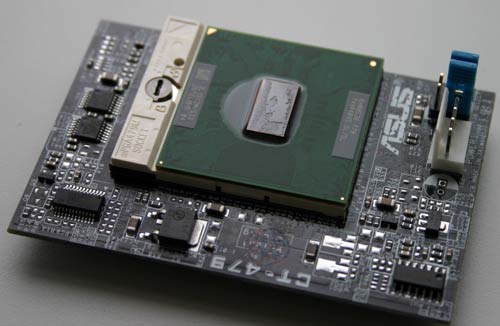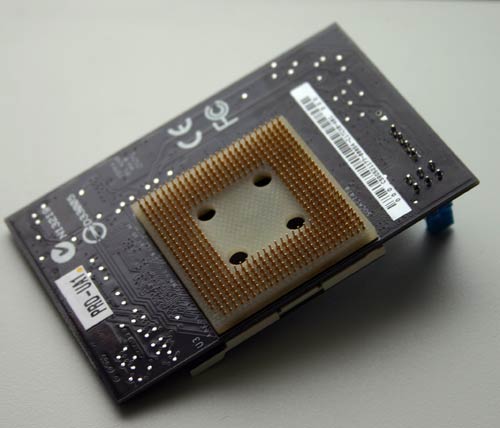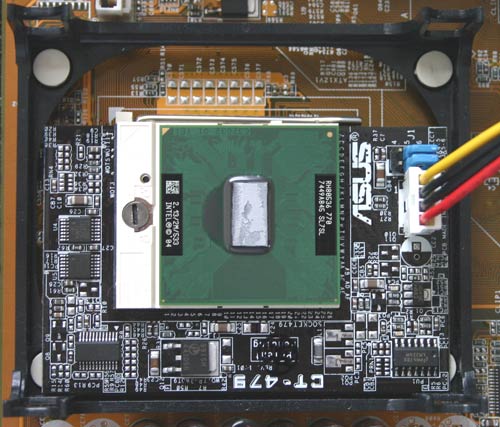Intel's Pentium M Desktop Part II: ASUS' Pentium M to Pentium 4 Socket Adapter
by Anand Lal Shimpi on March 24, 2005 1:31 PM EST- Posted in
- CPUs
ASUS CT-479: Socket-478 to Socket-479 Adapter
Enter the ASUS CT-479 CPU Upgrade Kit, an adapter board that will convert specific ASUS Socket-478 motherboards to support Pentium M CPUs. You will remember from our original Pentium M desktop article that the pinout of the Pentium M is different than the Pentium 4, although the two chips are electrically compatible (they use the same FSB). The next problem is that the Pentium M relies on a much lower voltage version of the Pentium 4's FSB, which is also addressed by ASUS' adapter, a problem that we did not think was solvable until now.
The CT-479 only works with ASUS motherboards, and only a limited number of them at that. Currently, only the ASUS P4P800-SE and P4P800-VM motherboards are supported, both of which are i865 based motherboards. ASUS is working on support for other boards; the P4C800-E (875P) will be supported soon. For our tests, we used a P4P800-SE; you need a BIOS update, but that's all. Obviously, non-ASUS motherboards are not supported; however, we're not certain whether or not the adapter can be made to work in other boards. We will be looking into this as time goes on, but we wanted to make sure that we could complete this article first before doing anything that would damage our setup.


The CT-479 supports all Pentium M and Celeron M CPUs (Dothan and Banias based) with the exception of the Low Voltage and Ultra Low Voltage versions.

The jumpers switch between 400 and 533MHz FSB settings. The power connector powers the adapter.
The CT-479 comes with the adapter board, heat sink/fan and power cable.

A perfect fit

The supplied heat sink is specifically made for the CT-479.
Currently, ASUS is listing the CT-479 as a part of a bundle with the P4P800-SE, priced at $130. At that price, the solution is almost half the price of the AOpen/DFI motherboards, and you get all of the benefits of the 865 chipset. The main benefit of the 865 chipset in this case is its dual channel DDR400 memory controller. The 533MHz FSB Pentium Ms are memory bandwidth starved by the 855GME's single channel DDR333 memory controller, so being paired with an 865 gives the CPU more memory bandwidth than it can use.
The P4P800-SE that we tested only allowed for 5:4 and 1:1 memory clock speed ratios, meaning that for our 533MHz FSB Pentium M, the maximum stock memory clock was DDR333. But since we're talking about a dual channel memory controller, even at DDR266 speeds, you have enough memory bandwidth for the processor - DDR400 support isn't necessary.
The other major benefit of the CT-479 is that you get to use a mature, mass-produced ASUS motherboard instead of a smaller production run, recently released 855GME solution. The benefits were clear in our testing - overclocking the Pentium M was far less of an ordeal on the ASUS solution.
The CT-479 does not support the Pentium M's SpeedStep technology, which has a handful of implications:
1) System power consumption will be higher on the ASUS solution than on 855GME based systems from AOpen/DFI. The reason being that the CPU will always run at maximum frequency, which is still lower power consumption than any other desktop processor, but it is worth mentioning.
2) You can't adjust the clock multiplier of the Pentium M like you can on the AOpen/DFI offerings. This will hamper the more adventurous overclockers, but it's definitely not a show stopper.
You also can't adjust the Pentium M's core voltage when using the CT-479; you're stuck at the default voltage. ASUS' Q-Fan technology (which allows for the automatic reduction of fan speed depending on thermal load) is supported, so you can reduce noise output even if SpeedStep isn't supported.
ASUS just announced the CT-479 last week, so there are some details that aren't yet available, such as whether or not the kit will be offered outside of the ASUS motherboard bundle. As soon as we have this information, we'll pass it along, but even if the only way to get it is with an ASUS motherboard, it is still a much better value than a standalone Pentium M motherboard.
The question here is how big of an impact does the 865 chipset have on the desktop performance of the Pentium M? To find out, we paired it with the Pentium M 770, Intel's fastest Pentium M running at 2.13GHz. The Pentium M 770 requires a 533MHz FSB, which is supported by the 865 chipset, and thus, is also supported by the CT-479 upgrade kit.
The Test
Our hardware configurations are similar to what we've used in previous comparisons.
AMD Athlon 64 Configuration
Socket-939 Athlon 64 CPUs
2 x 512MB OCZ PC3200 EL Dual Channel DIMMs 2-2-2-10
NVIDIA nForce4 Reference Motherboard
ATI Radeon X800 XT PCI Express
Intel Pentium 4 Configuration
LGA-775 Intel Pentium 4 and Extreme Edition CPUs
2 x 512MB Crucial DDR-II 533 Dual Channel DIMMs 3-3-3-12
Intel 925XE Motherboard
ATI Radeon X800 XT PCI Express
Intel Pentium M Configuration
Intel Pentium M 725 - 755
2 x 512MB OCZ PC3200 EL Dual Channel DIMMs 2-2-2-10
AOpen GMEm-LFS Motherboard
ASUS P4P800-SE + CT-479 Adapter
ATI Radeon X800 XT AGP










48 Comments
View All Comments
Spajky - Saturday, May 14, 2005 - link
Spajky - Saturday, May 7, 2005 - link
Some comments:http://www.anandtech.com/cpuchipsets/showdoc.aspx?...
>WinRAR 3.40
Pulling the hard disk out of the equation, we can get a much better idea of which processors are truly best suited for file compression<
>The WinRAR test is particularly memory bandwidth intensive, so the move to a platform that can feed the Pentium M adequately increases performance tremendously. However, even with the boost, the best that the Pentium M can do is match the performance of Intel desktop CPUs. It still can't touch the Athlon 64s<
Data compression, WinRAR 3.42, KB/s - Irrelevant CPU bench/graph !!!
It can be treated as a real life memory subsystem benchmark instead !
WinRAR´s built_in benchmark & hardware test" is NOT a Data Compression Bench :
some tests/benchmarks & explanation HOW IT WORKS, here:
http://freeweb.siol.net/jerman55/HP/benchMem.htm
Spajky - Saturday, May 7, 2005 - link
Some comments:http://www.anandtech.com/cpuchipsets/showdoc.aspx?...
>WinRAR 3.40
Pulling the hard disk out of the equation, we can get a much better idea of which processors are truly best suited for file compression<
>The WinRAR test is particularly memory bandwidth intensive, so the move to a platform that can feed the Pentium M adequately increases performance tremendously. However, even with the boost, the best that the Pentium M can do is match the performance of Intel desktop CPUs. It still can't touch the Athlon 64s<
Data compression, WinRAR 3.42, KB/s - Irrelevant CPU bench/graph !!!
It can be treated as a real life memory subsystem benchmark instead !
WinRAR´s built_in benchmark & hardware test" is NOT a Data Compression Bench :
some tests/benchmarks & explanation HOW IT WORKS, here:
http://freeweb.siol.net/jerman55/HP/benchMem.htm
Spajky - Saturday, May 7, 2005 - link
Some comments:http://www.anandtech.com/cpuchipsets/showdoc.aspx?...
>WinRAR 3.40
Pulling the hard disk out of the equation, we can get a much better idea of which processors are truly best suited for file compression<
>The WinRAR test is particularly memory bandwidth intensive, so the move to a platform that can feed the Pentium M adequately increases performance tremendously. However, even with the boost, the best that the Pentium M can do is match the performance of Intel desktop CPUs. It still can't touch the Athlon 64s<
Data compression, WinRAR 3.42, KB/s - Irrelevant CPU bench/graph !!!
It can be treated as a real life memory subsystem benchmark instead !
WinRAR´s built_in benchmark & hardware test" is NOT a Data Compression Bench :
some tests/benchmarks & explanation HOW IT WORKS, here:
http://freeweb.siol.net/jerman55/HP/benchMem.htm
Anemone - Sunday, April 17, 2005 - link
Curious how the XPS Gen2 would have faired in this battery of testing... the 915M seems to slightly better exploit the P-M from what I've been seeing, even though the XPS doesn't really focus on things other than gaming. However it would show what a performance focused chipset (and one that is meant to attempt to bring out the most in Dothan) is able to do under these same conditions. Yonah seems to be the magic juice though, but its sad that is really so far away from market. Intel would do well if they could bring Yonah faster to market, even if they had to keep speeds to the 2.2-2.4 range to do it.Quite an interesting article, and one I read carefully on every point.
ty
Calin - Tuesday, March 29, 2005 - link
An overclocked PM on top of the competition - even in a single benchmark? This chip is a big win for Intel, too bad that the big money come from the laptop world, where there is no competition. This is a guarantee for never decreasing prices for the Pentium M platformZebo - Monday, March 28, 2005 - link
Why's it so expensive? As far as overclocking, I don't see as it has value compared to A64, an already better rounded processor. You get a A64 3000 (which BTW has PCIe support) for $145 slam it to 2600Mhz pretty easy, 2900Mhz when Veince comes and it will destory any clock you can get out of PM. $145 super screamer :::slobber:::Meh. I'm not as excited as I once was about this chip. Everyone was saying how it's bandwidth staved in the 855 reveiws, turns out, yet again this was wishful thinking for the PM crowd desperate to see any light at end of intel tunnel. I notice no change in benchmarks with added BW.:|
fitten - Sunday, March 27, 2005 - link
#33, there's also the issue about how many data pins are exposed to the outside world. System memory DDR is 64-bits wide, as is the data bus external to the Pentium-M. Having dual channel (basically 128-bit wide memory) memory will help because the memory controller can read, in effect, two times the width each clock, but it still takes two transfers to get it across. The Athlon64 (S939 and S940) have 128-bit wide paths to memory and can transfer the entire width each transfer.valnar - Sunday, March 27, 2005 - link
I think many people, including Anand, are missing the point of the Pentium M. It was made to be a low powered, low heat processor. The fact it can even HANG with the big boys at their level is a remarkable achievement. (You can't say that about the VIA C3 processor.)Megahertz for megahertz, and watt for watt, it is easily the best processor on the market. You're comparing that against 3.8Ghz CPU's!! Of course it won't be first place. After all, it's just a 2.13Ghz. It uses 1/4 the power of the highest P4's. Compared against any other processor which comes close to those speed/power specs, it'll wipe the floor with them.
If Shuttle made their XPC's with this processor, I'd buy it in a heartbeat.
Rob
Slaimus - Sunday, March 27, 2005 - link
The real gem is the Celeron M Dothan. Need some benchmarks for that chip.